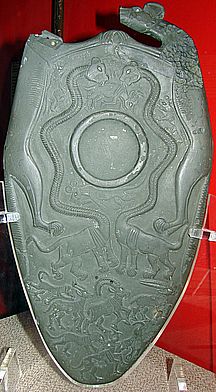 Middle Register.
Middle Register. | Go to
student resources page,
transit lounge, Essay on Egyptian Origins. |
Content Rewritten 111002 |
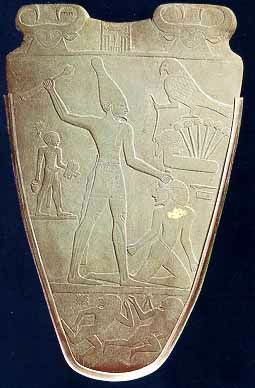
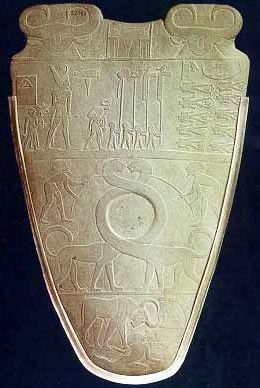
The magnificent “Palette of Narmer” is one of the most important artifacts ever found bearing on the unification of the early Egyptian state. The palette is made of greenish slate and is about 26 inches high.It portrays the culture hero Narmer, almost certainly a real person, in the act of subduing his enemies.
On one side he is wearing the crown of Upper Egypt, on the other the crown of Lower Egypt. It is the earliest surviving artifact to show a Pharaoh wearing the crowns of both Upper and Lower Egypt.
Most people interpret the palette as portraying the act of unification itself, although modern specialists are inclined to doubt that this was accomplished in any single battle, so that current opinion tends to see the palette as mythologizing the unification process a bit.
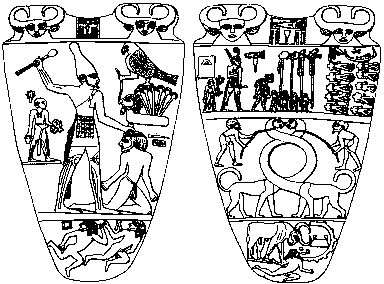
The quick story of this is that Narmer, the king (whatever that means) of Upper Egypt, shown on the reverse of the palette (at left here) wielding a mace, captures and destroys a nameless king of Lower Egypt, the one whose head is about he is shown about to smash. On the obverse (at right here) Narmer is shown again, in procession, with the headless bodies of his Lower Egyptian opponants laid out before him.
But who is Narmer? How do we know he is the figure shown by the palette? Why a palette? What are all those things being carried around on posts? Which side of the palette does the story actually start on?
The details are provided below.
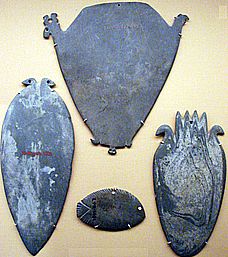
Palettes were used to grind minerals for use as pigments, much as Chinese artists to the present day grind ink on small palettes as they paint traditional watercolors. In the simplest form, most Egyptian palettes were simply pieces of stone (normally, I believe, slate), sanded smooth at the sides, and sometimes worked into nice shapes, like the ones shown at right from the Ashmolean Museum at Oxford.
However among the earliest palettes that are preserved, a few are in fact quite elaborately carved (or more exactly abraded and polished, since they are made of slate and are difficult to carve). Although the meanings of the motifs and the occasions for their use are unknown, it is unlikely that they are just rich people's versions of humble, more work-a-day palettes, since they would, in fact, be rather clumsy to use merely to grind pigments. The beautiful palette the two sides of which are shown here (now in the Louvre) is an example of such a work. Who are all those dogs? What are the other animals? Why would this have been made, anyway?
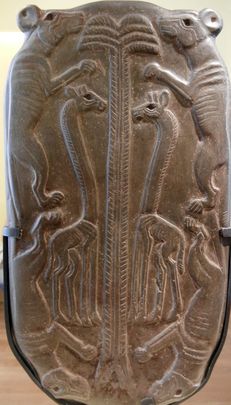
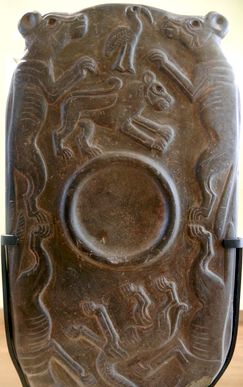
So far fragments of at least twelve similarly "over-elaborate" palettes are known from early Egypt, mostly too fragmentary for us to know what they portrayed. We must suppose that they may have been used in a very limited way for military, political, or religious ritual. If it was ritual grinding, we might imagine preparing cosmetics for a temple statue, for example.
But most specialists assume that such a palette was probably a ceremonial object in that shape, never put to use for grinding at all, much as our academic processions are sometimes headed by a university officer carrying a mace, which looks impressive and in theory symbolizes authority, but is never actually used to crack any heads.
(UCSD possesses a fine mace, certainly heavy enough to shatter even the hardest head, that is used in graduation processions. But most graduating students have their mind on other matters and are probably unaware that the object they march behind symbolizes head cracking.)
Some specialists have proposed that the palettes were “votive,” that is, made to serve as offerings, perhaps to be included in foundation deposits of buildings, but they have not been found in original contexts, so there is no way to confirm this.
On the Palette of Narmer, the side containing the grinding surface (and hence designated as the "obverse") confines the grinding surface inside a circle between the intertwined necks of two captive fabulous beasts, sometimes interpreted as “lions.”
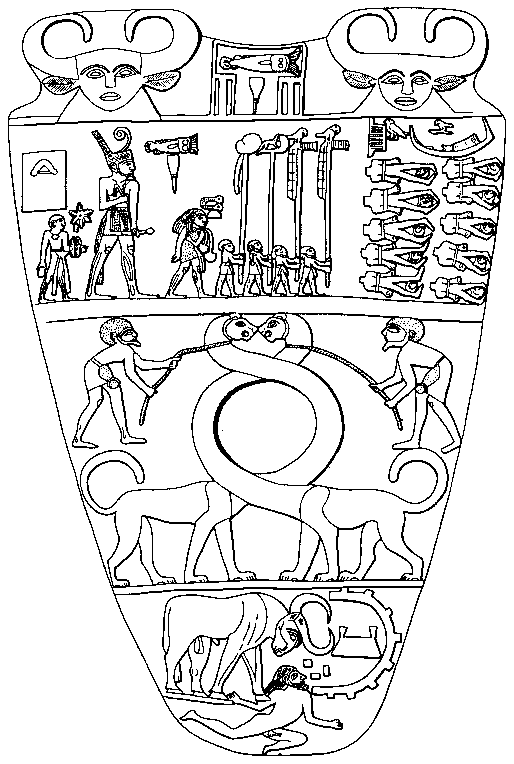
 Middle Register.
Middle Register. 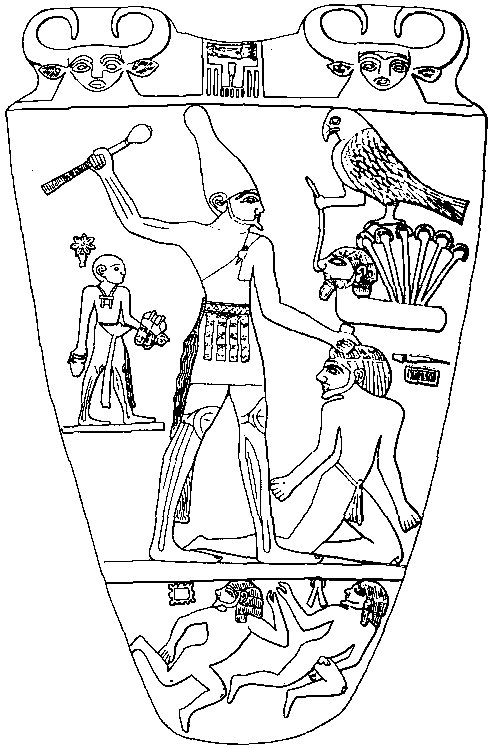
The Palette of Narmer is in the Egyptian Museum in Cairo. Other palettes shown here are from the Ashmolean Museum at Oxford University and from the Musée du Louvre in Paris. Various text sources were consulted in preparing this page and intepreting the palettes. Of them the most important was:
- KINNAER, Jacques
- 1999 The Narmer Palette: a closer look. The AIA Glyph [San Diego] 1(18): 8-9. (Kinnaer’s web site is: http://www.ancient-egypt.org.)